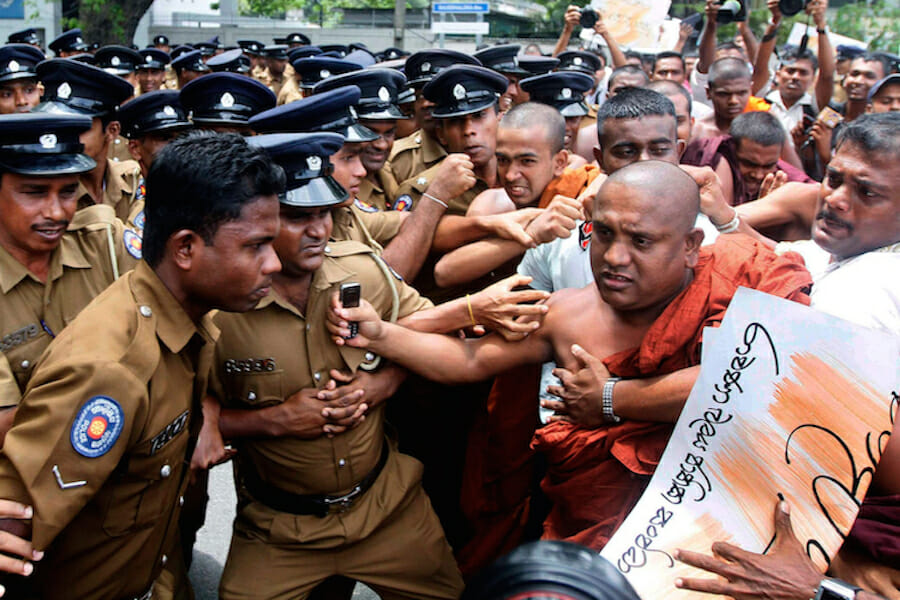
Interview with Sri Lanka’s The Social Architects
For those that follow developments in Sri Lanka over the past several years invariably the Sri Lankan Civil War comes to mind. The Sri Lankan Civil War began back in July of 1983 and was fought between the Liberation Tigers of Tamil Eelam (LTTE) or the Tamil Tigers and Sri Lankan government forces. The goal and objectives of the Tamil Tigers was to create an independent Tamil state called Tamil Eelam in Sri Lanka’s north and the east. The civil war ended in May of 2009.
In understanding the root causes and the ramifications of the civil war and what needs to be done to heal the deep divide that separate Tamils from the rest of Sri Lankan society I turned to The Social Architects. I became familiar with the work of The Social Architects through Gibson Bateman a frequent contributor to this website. Gibson has written a number of articles that detail the atrocities committed by the government in several of his articles.
Sri Lanka’s brutal war came to an end in 2009, but the country’s ethnic conflict remains unresolved. The Social Architects, a research and advocacy group, were created in early 2012. Since then, their work has garnered a significant amount of attention – both in South Asia and in other places such as the United States, Canada, and the United Kingdom.
For people not familiar, can you give some background information on your group’s mission, membership, and goals?
We are a diverse group of writers, activists, scholars and working professionals. Most of our members are from Sri Lanka’s North and East, but our group also includes people who were not born in Sri Lanka.
The group is composed of less than ten core members who are residing in various places, including Sri Lanka. In addition to our extensive network within Sri Lanka, TSA also has contacts in North America, Europe, and India.
TSA’s mission is to inform, to educate and to provide timely, thoughtful analysis on Sri Lankan affairs – particularly Tamil issues, human rights trends, and the root causes of Sri Lanka’s longstanding ethnic conflict.
Can you describe what the root causes of the Sri Lankan civil war were?
This is a very complex issue, however, I will try to give a simplified response. The concerted effort by the colonial powers to “consolidate first then divide and rule” and the project by the post-independence rulers to consolidate a unitary Sinhala state by institutionalizing structural inequalities can be sited as the root causes. It started with language and spread to education, water, land, and the interpretation of the past. Post-independence discourse never included a concept of a shared political future but a discourse on how to promote the exclusion of Tamils from state machinery and power, which created the ethnic majoritarian democracy. This resulted in the solidification of the Sinhala Buddhist identity as the Sri Lankan State identity where others couldn’t fit in.
What are the long-term ramifications of the Sri Lankan civil war?
The Government of Sri Lanka (GoSL) is continuing with its systematic effort to reduce the population of the Tamils on the island. One needs to pay attention to the phenomena of a “lost generation” and an increasing variance in the male to female ratio. There’s also a “victor’s agenda,” where the GoSL is penalizing the people who lost the war and endowing the other. It’s about these two different communities.
The word reconciliation loses its essence within the context of a “Winner takes it all” policy, which is based upon satisfying the psyche of the victor. The GoSL is pushing people into a revenge mode instead of a reconciliation mode. Losing police powers, losing land powers, including private land – it looks like the victor can take whatever s/he wants. Also, the fact that there’s been no accountability just encourages more violations, which are still very prevalent.
Tamils are also at risk of losing their culture and language. The military’s job description includes propagating Sinhala Buddhism. For example in the Eastern Province of Sri Lanka, there’s an ancient Hindu temple (extensively used by the habitants of that area who are Hindu Tamils) which is currently being used to store a generator. This generator is used solely to illuminate the Buddhist temple built by the army post-May 2009. It is worth noting, not a single Buddhist civilian lives in this area. This simple example is a glimpse into the long-term ramifications of what’s happening now. The name of this village has also been changed and very soon we will see that Sinhala communities are given land as a gift for voting for a particular political party. It is not cash for vote, but land from North and East for your vote.
What are the stumbling blocks for reconciliation in post-war Sri Lanka?
The greatest stumbling blocks to reconciliation are President Rajapaksa’s deeply intolerant policies and misguided strategy (focusing almost solely on economic development and the rebuilding of infrastructure) since the conclusion of the war. The government has consistently failed to follow-through on its commitments regarding a political solution and continues to promote a victor’s agenda, which focuses more on majoritarian triumphalism and the veneration of the military than it does on reconciliation, human rights or even the most basic principles associated with democratic governance. Rajapaksa’s administration is very keen on the centralization of power and ensuring that any meaningful devolution – especially in the North and East – remains a distant dream.
Perhaps most discouraging – more than four years since the end of the war – the situation is still worsening, from custodial deaths in Vavuniya to an even larger outbreak of violence in Welikada to the impeachment of the chief justice. More recently, we’ve seen the military murder three people in Weliweriya and the continuation of religiously motivated violence. The situation in Sri Lanka keeps getting worse. There was some thought that the government might try to show meaningful progress in light of CHOGM being held in Colombo and the possibility of another HRC resolution in March 2014, but now I’m very skeptical that even those types of international events will convince the regime to change its behavior – which might include finding a political solution, respecting human rights and the independence of the judiciary, implementing a number of the very reasonable LLRC recommendations and proving to people that Sri Lanka is not turning into a dictatorship.
Has the international community done enough to press the issue of resettlement, return and addressing a political solution?
The International Community (IC) hasn’t done enough. The IC was more concerned about resettlement than return. This is also a reason why land issues are so prevalent in the North and East. The IC has also contributed to some of the land problems we have right now. This is a classic example of where, if you only put a band-aid on a problem, and don’t address the root causes, then things may only get worse. Much of this has been done in the name of sovereignty and non-interference.
In regards to political solution, I want to draw attention to the Joint Communiqué of May 26th (SG2151) by the UN Secretary- General and the Government of Sri Lanka which states “President Rajapaksa expressed his firm resolve to proceed with the implementation of the 13th Amendment, as well as to begin a broader dialogue with all parties, including the Tamil parties in the new circumstances, to further enhance this process and to bring about lasting peace and development in Sri Lanka.”
However, the reality is very different after four years. Anything that is of any significance in the 13th amendment to the Constitution of Sri Lanka is being diluted or removed by another Bill or directive. To achieve this, the present regime even impeached the Chief Justice. The hope for a political solution is a dead hope for many Tamils in Sri Lanka. We the Tamils don’t feel we are entitled to a shared sovereignty.
Moving forward, what do you wish to see happen in Sri Lanka?
Soundra Mahalakshmi: Reduce the military’s presence, have a genuine rehabilitation process for ex-combatants, provide psychological assistance to all of those who need it, and to have an independent judiciary.
Gibson Bateman: For the government to begin to engage with the most essential LLRC recommendations related to human rights, land, and governance.
Rathika Innasimuttu: We have two HRC resolutions which have not resulted in any change on the ground. Therefore, we would like an international commission of inquiry to bring back confidence within communities so that people will still believe in values such as Truth and Justice.
Do you envision another bloody civil war down the road?
Gibson Bateman: If the Rajapaksa administration continues to alienate ethnic Tamils and promote a deeply intolerant, Extremist Sinhala Buddhist ideology, I think a return of violence – in some fashion – is inevitable.

